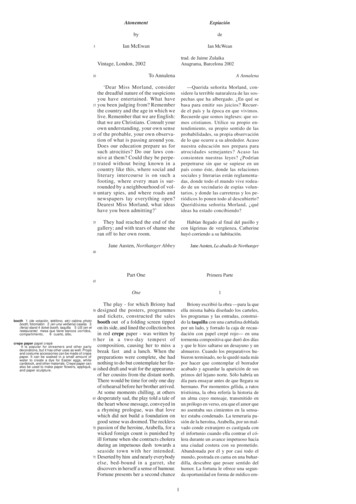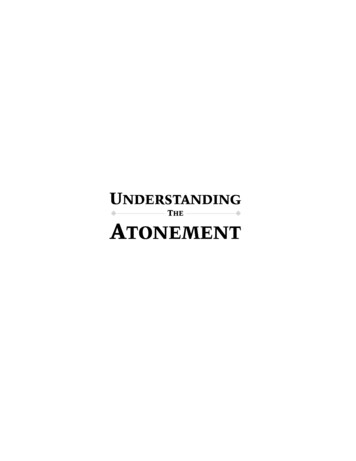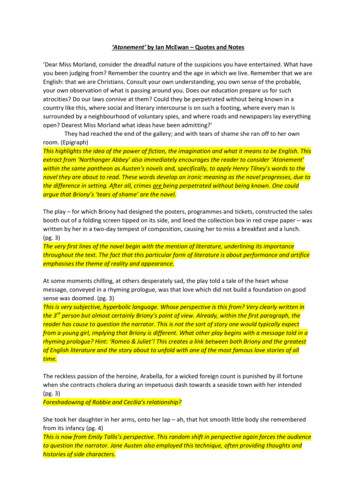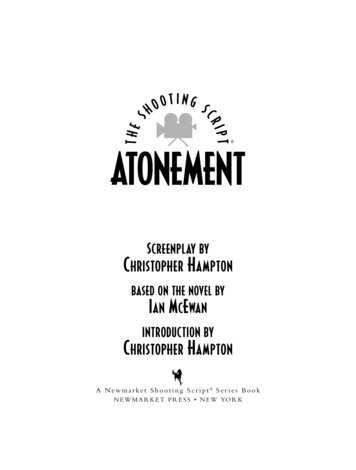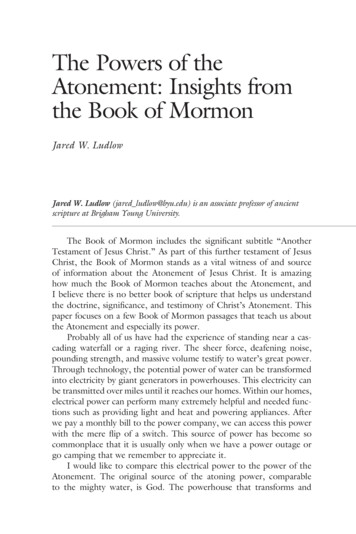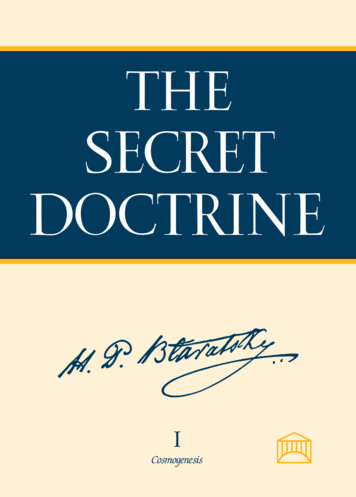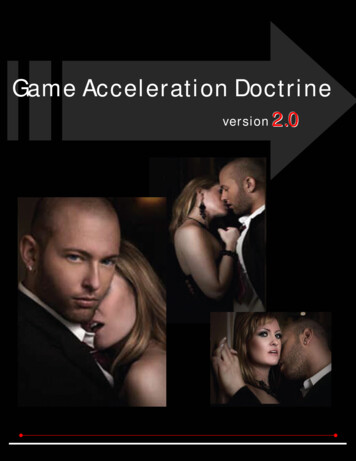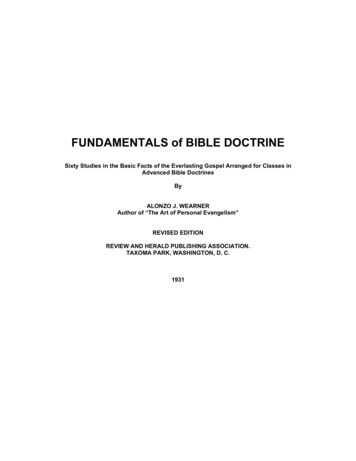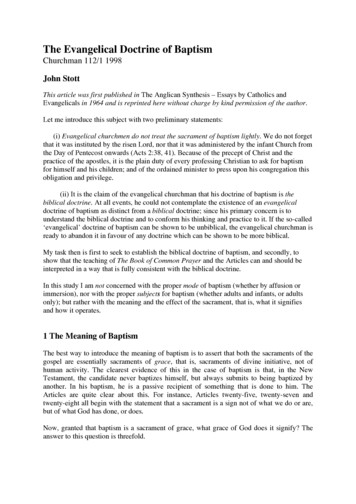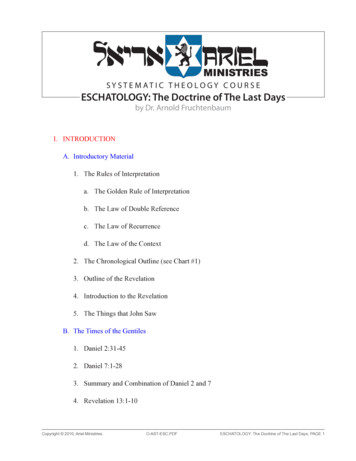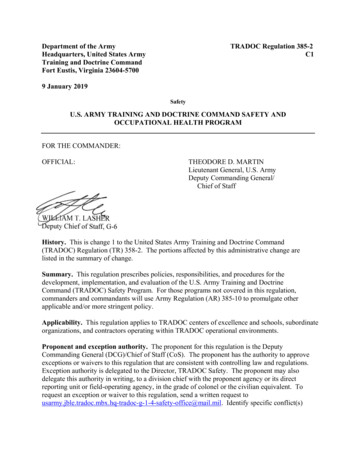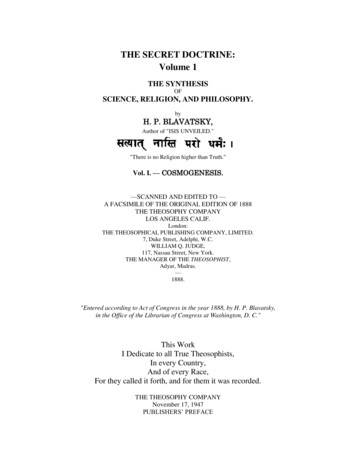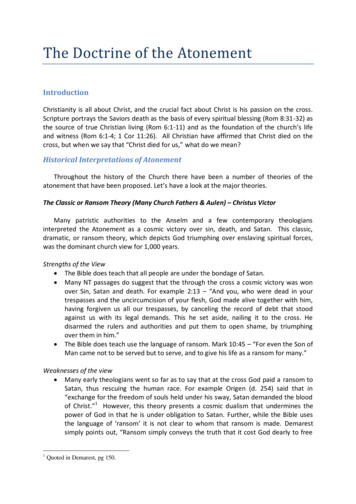
Transcription
The Doctrine of the AtonementIntroductionChristianity is all about Christ, and the crucial fact about Christ is his passion on the cross.Scripture portrays the Saviors death as the basis of every spiritual blessing (Rom 8:31-32) asthe source of true Christian living (Rom 6:1-11) and as the foundation of the church’s lifeand witness (Rom 6:1-4; 1 Cor 11:26). All Christian have affirmed that Christ died on thecross, but when we say that “Christ died for us,” what do we mean?Historical Interpretations of AtonementThroughout the history of the Church there have been a number of theories of theatonement that have been proposed. Let’s have a look at the major theories.The Classic or Ransom Theory (Many Church Fathers & Aulen) – Christus VictorMany patristic authorities to the Anselm and a few contemporary theologiansinterpreted the Atonement as a cosmic victory over sin, death, and Satan. This classic,dramatic, or ransom theory, which depicts God triumphing over enslaving spiritual forces,was the dominant church view for 1,000 years.Strengths of the View The Bible does teach that all people are under the bondage of Satan. Many NT passages do suggest that the through the cross a cosmic victory was wonover Sin, Satan and death. For example 2:13 – “And you, who were dead in yourtrespasses and the uncircumcision of your flesh, God made alive together with him,having forgiven us all our trespasses, by canceling the record of debt that stoodagainst us with its legal demands. This he set aside, nailing it to the cross. Hedisarmed the rulers and authorities and put them to open shame, by triumphingover them in him.” The Bible does teach use the language of ransom. Mark 10:45 – “For even the Son ofMan came not to be served but to serve, and to give his life as a ransom for many.”Weaknesses of the view Many early theologians went so far as to say that at the cross God paid a ransom toSatan, thus rescuing the human race. For example Origen (d. 254) said that in“exchange for the freedom of souls held under his sway, Satan demanded the bloodof Christ.”1 However, this theory presents a cosmic dualism that undermines thepower of God in that he is under obligation to Satan. Further, while the Bible usesthe language of ‘ransom’ it is not clear to whom that ransom is made. Demarestsimply points out, “Ransom simply conveys the truth that it cost God dearly to free1Quoted in Demarest, pg 150.
sinners from spiritual enslavement.”2 And further he goes on to say (speaking aboutPaul’s use of ransom language), “The question, to whom was the price paid? Goesbeyond the main point Paul sought to make.”3Further, it minimizes the role of forgiveness by teaching that God does not need toforgive, but to rescue.The Satisfaction or Juridical Theory (Anselm)Anselm was one of the chief theologians of the medieval scholastic period. He was thetheologian who first came up with the classic arguments for God (Cosmological, Moraletc.). Anselm taught that Man’s sinfulness has wounded God’s honour. God, out ofnecessity, restored his honour by sending Christ, both God and man, who restored Hishonour and gained a reward that He did not need, since He had everything. This reward isoffered to man in the form of merit and grace.Strengths It places the focus upon God, not Satan. Rather than Satan as the one to whom theransom had to be paid Anselm viewed that man had sinned against God. Further, it takes sin seriously. Sin is against God and his honour.Weaknesses It makes the atonement necessary, not only for us and our salvation, but for God andHis honour. Focus is unduly placed on God’s offended honour rather than on His breachedrighteousness. Later, Roman Catholic thought picked up this theory of atonement and developed afull system of penance and merit.23Demarest, 176.Ibid.
Moral Influence TheoryProponents claim that Christ’s death accomplished nothing objective; there were noobstacles in God that needed to be overcome in order for sinners to be restored tofellowship with their Creator. The sole barrier to salvation lies in estranged personthemselves, i.e. in their ignorant minds and proud wills. This theory maintains that God’slove displayed on the cross overwhelms sinners’ resistance and persuades them to repentand be reconciled to God.Strengths The life and death of Christ is a motivating factor in our lives. We are drawn to Christby seeing his love for us on the cross. We are all to follow Christ in carrying our own cross (Matthew 10:38). The cross is anexample for us to follow.Weaknesses It undermines the seriousness of sin and elevates God’s love at the expense of Hisrighteousness. It disregards all imagery of a necessary sacrifice. The Bible teaches that forgiveness isbased upon punishment, not baseless benevolence (Hebrews 9:22). The reason the cross of Christ is such a great expression of the love is preciselybecause it has some objective value. The suffering of Christ was not just physical, butwas also spiritual as he bore the punishment for the sins of the world.The Governmental TheoryMain proponent Grotius argued that Christ did not bear the full penalty of human sin, nordid he propitiate the divine wrath. Grotius maintained the objectively Christ by his deathmade a token, rather than a full or equivalent, payment to God for human sins. Through thedeath of his Son, God upheld the moral governance of the universe while setting aside therequirement of the law that sinners must be punished.
Main Points God could have relaxed His moral law and forgiven sinners, but then this would havecaused moral anarchy. God chose to demonstrate His moral government by punishing Christ for sin. Christ could not have paid the exact penalty for our sins since He is not eternallypunished in Hell. If Christ completely paid for the sins of man, then all people are forgiven and will goto heaven. God would have no right to demand faith and obedience, since all areobjectively forgiven.Strengths Seeks to uphold God’s moral law.Weaknesses Makes the atonement optional; God could have accomplished it another way. This is not an actual substitution since only a token penalty was paid.Penal Substitution TheoryAccording to this view sin, which is primarily a violation of God’s law, not his honor, resultsin the just penalty of death. But in love Jesus Christ, our substitute, in his life perfectlyfulfilled the law and in death bore the just penalty for our sins. On the cross Christ took ourplace and bore the equivalent punishment for our sins, thereby satisfying the just demandsof the law and appeasing God’s wrath. As repentant sinners appropriate Christ’s vicarioussacrifice by faith, God forgives sins, imputes Christ’s righteousness, and reconciles theestranged to himself.StrengthsIt takes God’s righteousness seriously.It shows the severity and necessity of theatonement.It has the most biblical support.The strengths of the other positions can bebrought together and rightly understoodunder substitionary atonement.WeaknessSometimes in emphasizing substitutionsome evangelicals forget to celebrate themany contours of the cross that are present within that Scriptures and therefore missout on the richness of the cross for their worship and sanctification.
Major ThesisSubstitutionary Atonement is the central atonement motif of the Bible, but throughthis motif the other contours of the Cross come to RECONCILIATIONThe Heart of Substitutionary AtonementSubstitutionary atonement rests on four concepts.1) Sin results in death: Man is sinful and has broken God’s law incurring the penalty ofdeath.2) God requires justice: The breaking of the law results in the wrath of God towardshumanity and that wrath needs to be satisfied.3) In our place: Christ substitutes himself and dies in our place taking on himself thewrath of God and dying the death we should have died.4) Imputation: A great exchange occurs on the cross. Our sin is placed on Christ and hisrighteous is imputed to us, so that we are forgiven.
The Biblical Support for Substitutionary AtonementIt is my contention that these for concepts are found all the way throughout the Bible andthat Substituionary Atonement is the most biblical theory of Atonement.A. The Substitutionary Atonement of Christ was prefigured in the sacrifices of OT.1. Dispensation of Innocence: Cain and Able first mention of sacrifice. Cain’s sacrificewas acceptable to God; we read that “the Lord looked with favor on Abel and hisoffering.”2. Dispensation of Conscience: Noah sacrificed burnt offerings to God for deliverancefrom the deluge (Gen 8:20).3. Dispensation of Patriarchs: Abraham, Isaac and Jacob had altars where they offeredsacrifices. Abraham’s near slaying of Isaac as a burnt offering in the region of Moriahprefigured the substitutionary death of the Messiah two millennia later. Isaacascended the mountain bearing the wood upon which the sacrifice would be laid.When he inquired about the lamb for the burnt offering, Abraham responded, “Godhimself will provide the lamb for the burnt offering, my son” (v.8). As Abraham wasabout to slay his son on the altar, the angel of the Lord showed him a ram caught ina thicket. Abraham then “took the ram and sacrificed it as a burnt offering instead ofhis son.” (22:13). The phrase, “instead of his son” affirms the substitutionary natureof the animal sacrifice.4. Dispensation of the Law: Passover main sacrifice – this atoning sacrifice resulted inIsrael’s deliverance from the land of bondage (Ex 14). We may say that the blood ofthe Passover sacrifice had a certain atoning power and anticipated the blood of theLamb shed on Calvary that would remove sins and avert the divine wrath (Jn 1:29;Rom 3:25; Heb 2:17).4 The Levitical sacrifices had also the idea of Atonement inthem; the worshiper would place their hand on the sacrifice to signify theirdeification with the sacrifice. The Day of Atonement also depicts substitution, for itshows the holiness of God, the gravity of sin, and God’s gracious provision byvicarious sacrifice. Important in OT times atonement was wrought not on the basisof a person’s best works but solely through God’s free grace and mercy. Ot peoplewho practiced the prescribed sacrifices and offerings in repentance and faith towardGod were saved by the yet future work of Christ prefigured by those rites (Rom3:25). Thus the faithful OT worshiper received pardon of sins – yet a remission thatwas less than permanent – and they experienced genuine fellowship with God – yet44In Leon Morris’ book the Apostolic Preaching of the cross, he points out that there are a number of lambsmentioned in Scripture. 1) Passover over lamb 2) The lamb that is led to slaughter 3) The suffering servant 4)the daily sacrifice 5) The gentle lamb (Jer 11:19) 6) The scapegoat 7) The triumphant lamb of the revelation 8)The Lamb that God provides.
a relationship that was than perfect. (As the Book of Hebrews suggests). 4Limitations of OT sacrifices:A. The sacrifices themselves were unable fully to atone for sin, as several Otwriters attest (Ps 40:6; 51:16; Hos 6:6; Mic 6:6-8).B. The blood of bulls and goats could not clear the consciences of the offers(Heb 9:9-10; 10:4).C. The OT sacrifices, offered day by day, year after year (Heb 9:25; 10:11)could not permanently remove the stain of repeated sins, but were areminder.D. The Ot sacrifices under the Old covenant were incapable of giving thepromised eternal inheritance (Heb 9:15), this must await the inaugurationof the New covenant.B. Substitionary Atonement was predicted in the OT prophetsThe prophets vividly portrayed the passion of the future “servant” and “branch.” Ps 22: Although it speaks directly of David’s trials, the poet’s vision transcends thepresent to embrace the Messiah’s future passion. It portrays the Messiah’s Godforsakenness verse 1 (My God My God why has thou forsaken me, Matt 27:46), 7-8portray the insults hurled at Christ at Calvary (Matt 27:39) and 14-15 his physicalsuffering and 18 the dividing of his garments. Zechariah: He acted out a drama which depicted the sale of the Good Shepherd for amere thirty pieces of silver. (Zech 11:12-13) Isaiah: He predicted –1) The terrible physical and emotional pain the Messiah neither registered norshrunk back from (Isa 50:5).2) The maltreatment by the people and his patient endurance of sufferings (Isa53:6-7) and disfigured appearance (Isa 52:14).3) Numbered among criminals (Isa 53:12) given an unfair trial and his life were cutoff by a violent death (Isa 53:8).4) Describes the substitution of the atonement in fourth servant song. (Isa 52:1353:12) “He took up our infirmities and carried our sorrows.” “He was woundedfor our transgressions and he was crushed for our iniquities.” Daniel: Daniel 9:24 “To finish transgression, to put as end to sin, to atone forwickedness, to bring in everlasting righteousness.” Conclusion: The prophets predicted the passion of the Christ and made it clear it wason our behalf.C. Substitutionary Atonement in the NT.1. In the Gospels: In the life of Christ his whole life was a sacrifice to God. By fulfillingthe law, Christ was righteous and able to atone for our sins and impute hisrighteousness to our account. Mark 10:45 “But the man did not come to be served,but to serve, and to give his life a ransom for (anti) many.” Use of anti prepositionwhich means “instead of.” Further the Lord’s Supper reveals the substitution ofChrist, Lk 22:19 “This is my body given for (hyper – on behalf of) of you.” Thereafterthe Lord took the cup of the wine, gave thanks, and said, “This cup is the newcovenant in my blood, which is poured out for you.” Once again the Greek
preposition “hyper” in these texts means “on behalf of” or “in place of” and soconnotes both representation and substitution.2. In the Pauline Corpus: In Paul’s writings we have the clearest teaching onsubstitionary atonement. 1
Makes the atonement optional; God could have accomplished it another way. This is not an actual substitution since only a token penalty was paid. Penal Substitution Theory According to this view sin, which is primarily a violation of God’s law, not his honor, results in the just penalty of death. But in love Jesus Christ, our substitute, in his life perfectly fulfilled the law and in death .File Size: 1MBPage Count: 11
